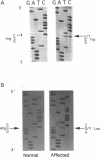Abstract
BACKGROUND--Mutations in the cardiac beta myosin heavy chain gene causing hypertrophic cardiomyopathy have been identified, and to assist both diagnosis and prediction of outcome attempts have been made to correlate phenotype and genotype. Two new mutations in codon 403 of the gene in three unrelated families are described and attention drawn to variable or even absent phenotypic expression in different family members. METHODS AND RESULTS--The polymerase chain reaction and heteroduplex analysis on Mutation Detection Enhancement gels were used to search for mutations in the globular head of the beta myosin heavy chain gene in families with hypertrophic cardiomyopathy. Two mutations were found in exon 13 (codon 403) of the gene. In two unrelated Polish families the mutation resulted in the conversion of arginine to tryptophan (CGG-->TGG). A second mutation, found in a British family, converted the same arginine to leucine (CGG-->CTG). These mutations were detected in family members who had electrocardiographic and echocardiographic features typical of hypertrophic cardiomyopathy; however, they were also detected in 7 other adult relatives with an abnormal electrocardiogram but a normal echocardiogram. Two unrelated adult relatives had completely normal clinical findings but carried the gene mutation. CONCLUSIONS--Identification of a specific mutation gives no guide to the clinical phenotype. There is considerable variability in the phenotypic expression of hypertrophic cardiomyopathy. Mutations were detected in adults previously regarded as normal or in whom the diagnosis was questionable. The fact that the clinical significance of the mutation in these people is still unknown emphasises the dilemma facing screening programmes. Isolated, unexplained electrocardiographic abnormalities in first degree relatives in a family with a definitive diagnosis of hypertrophic cardiomyopathy should be regarded as evidence of a carrier state.
Full text
PDF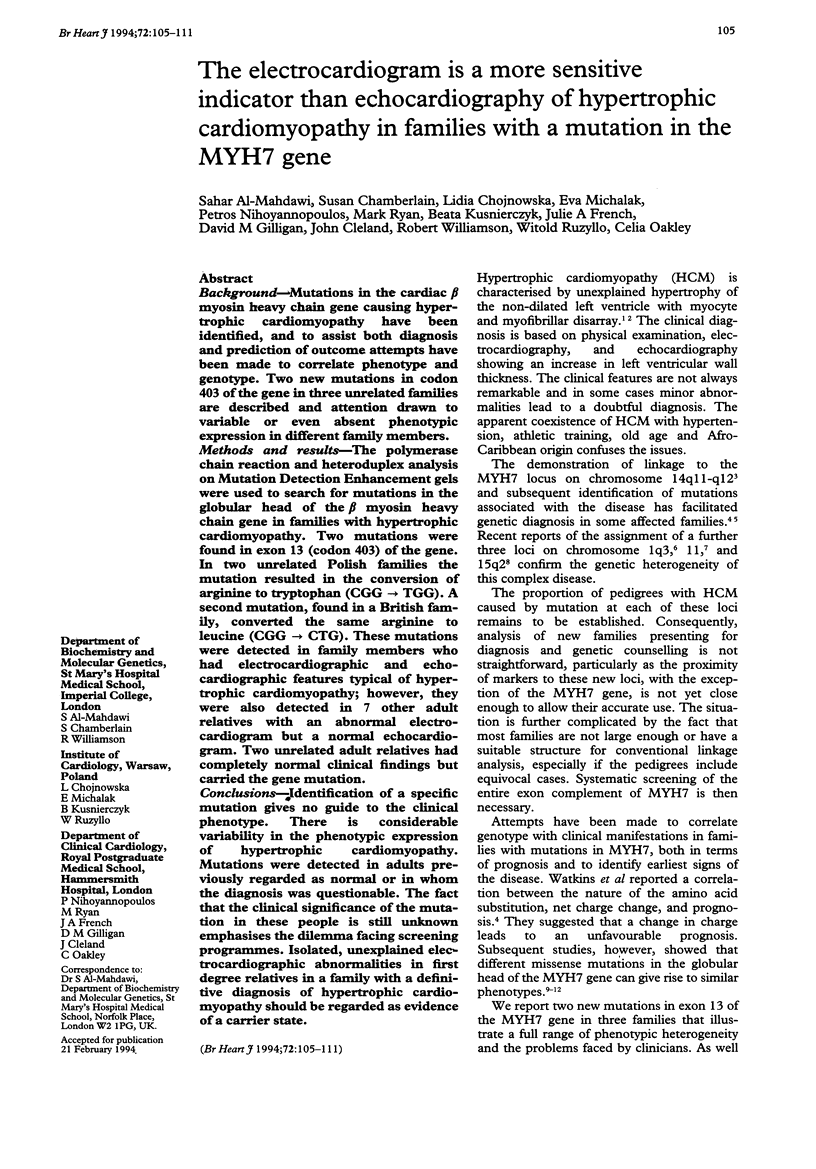
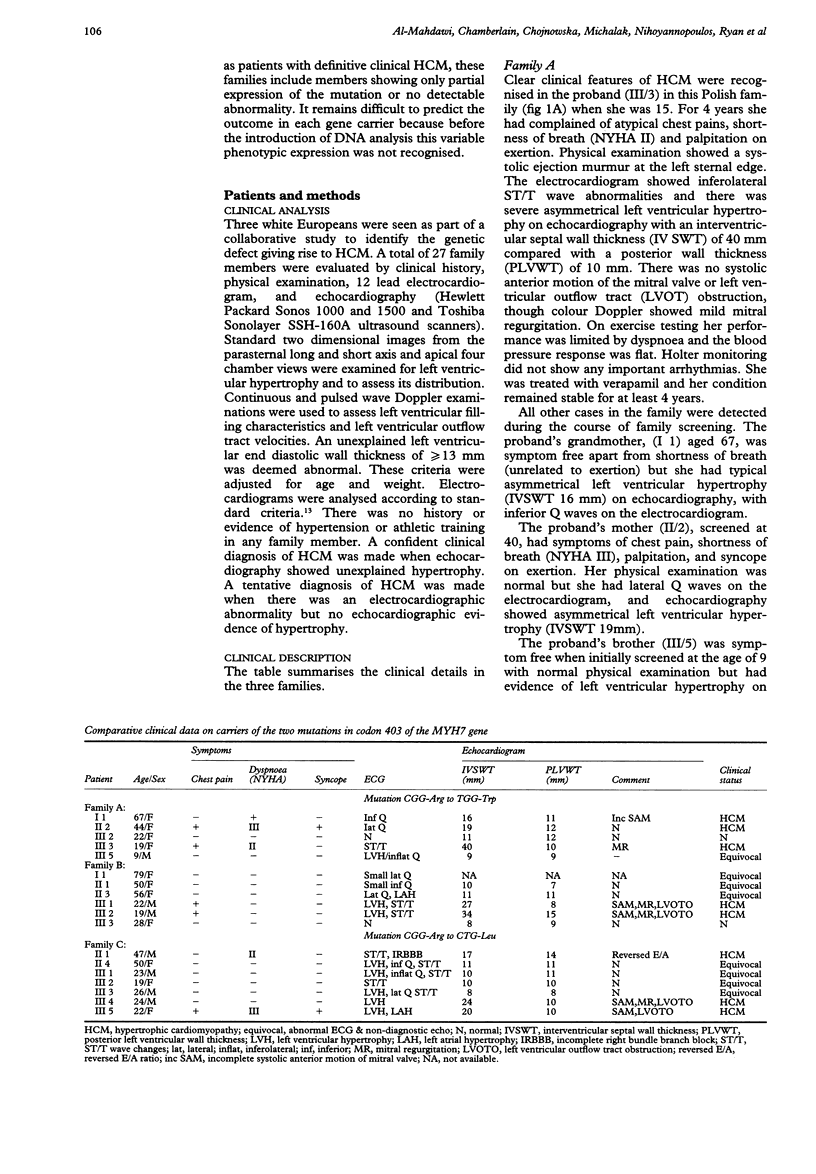
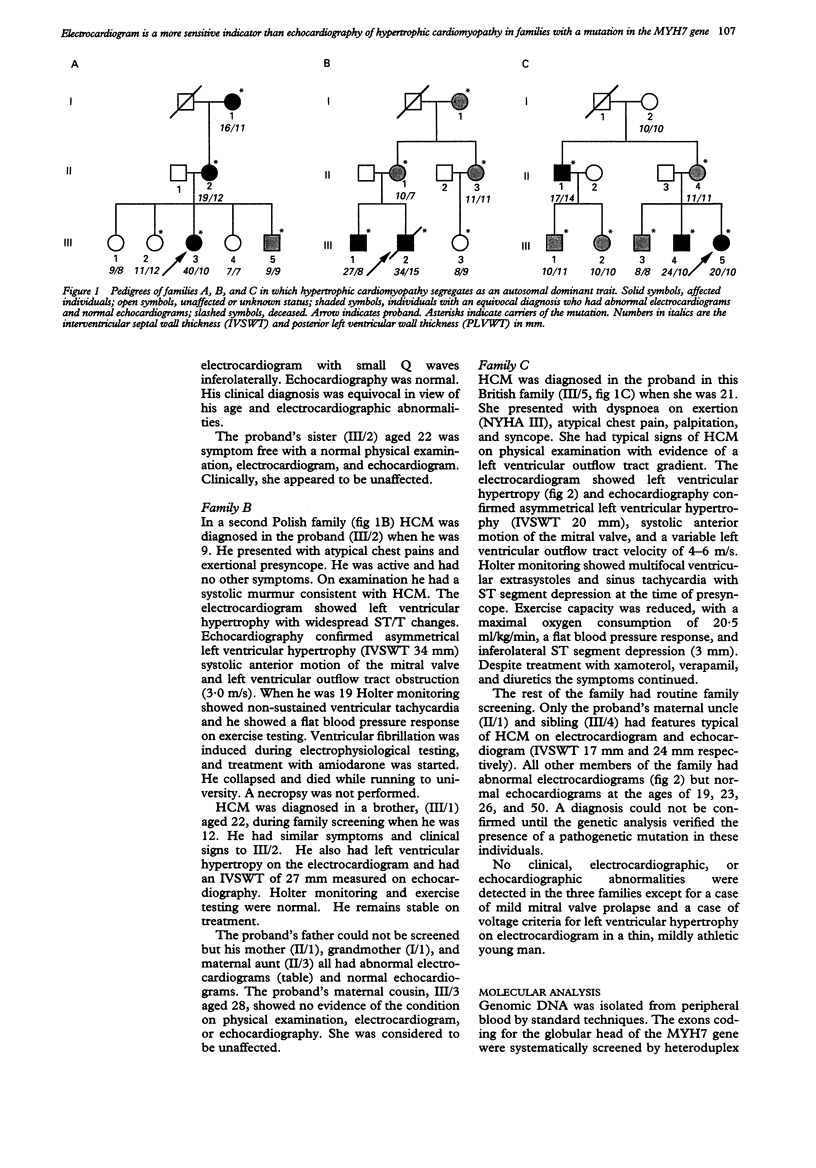
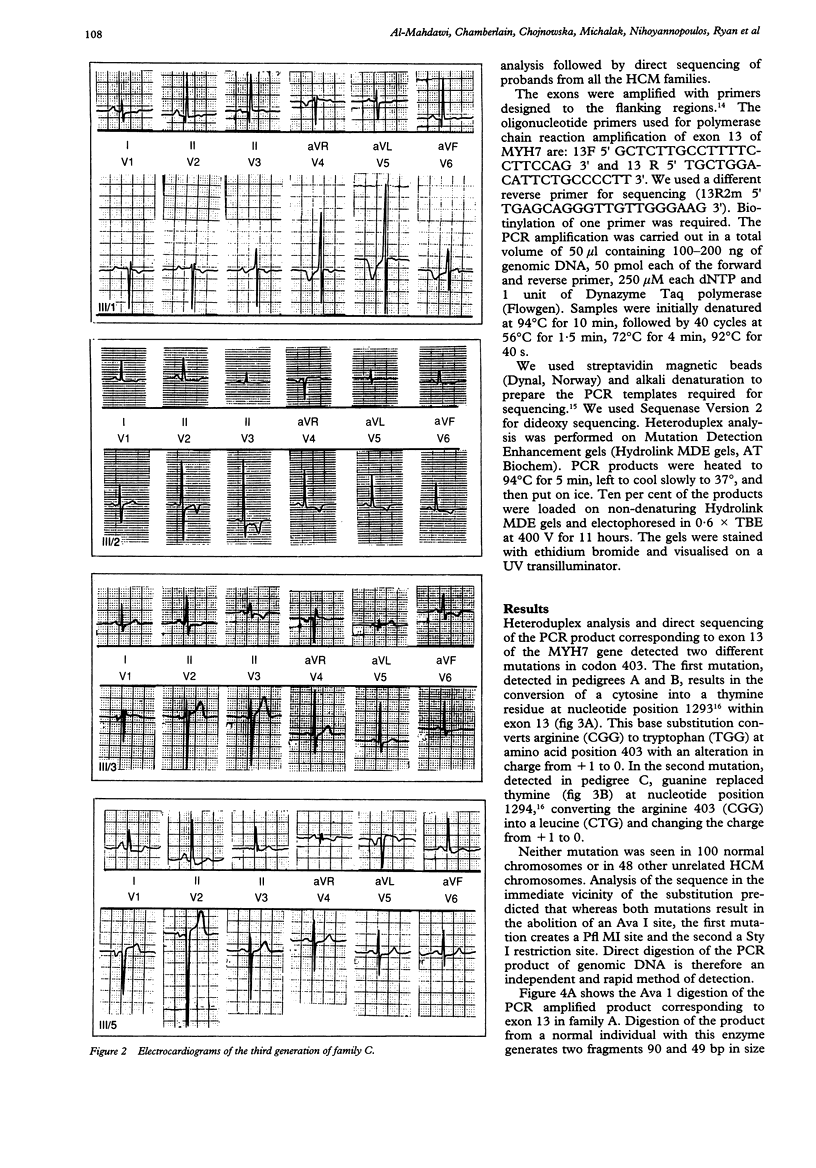
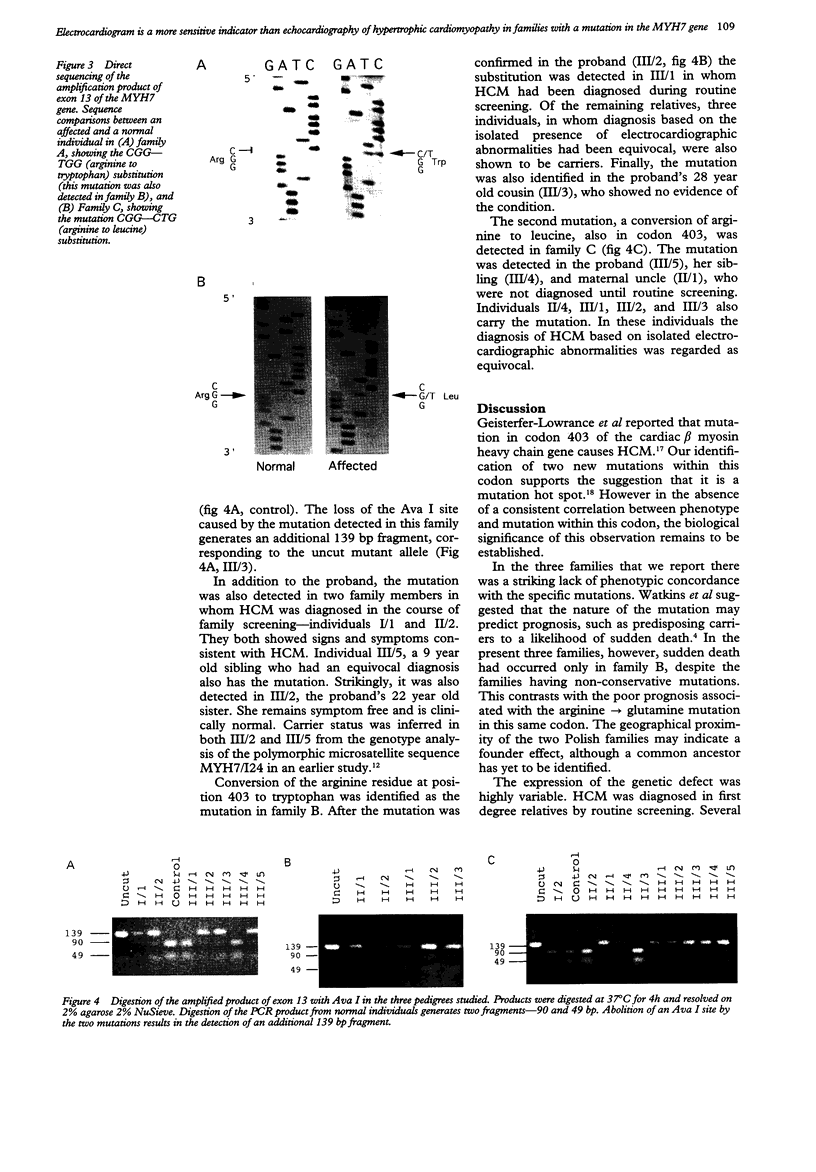
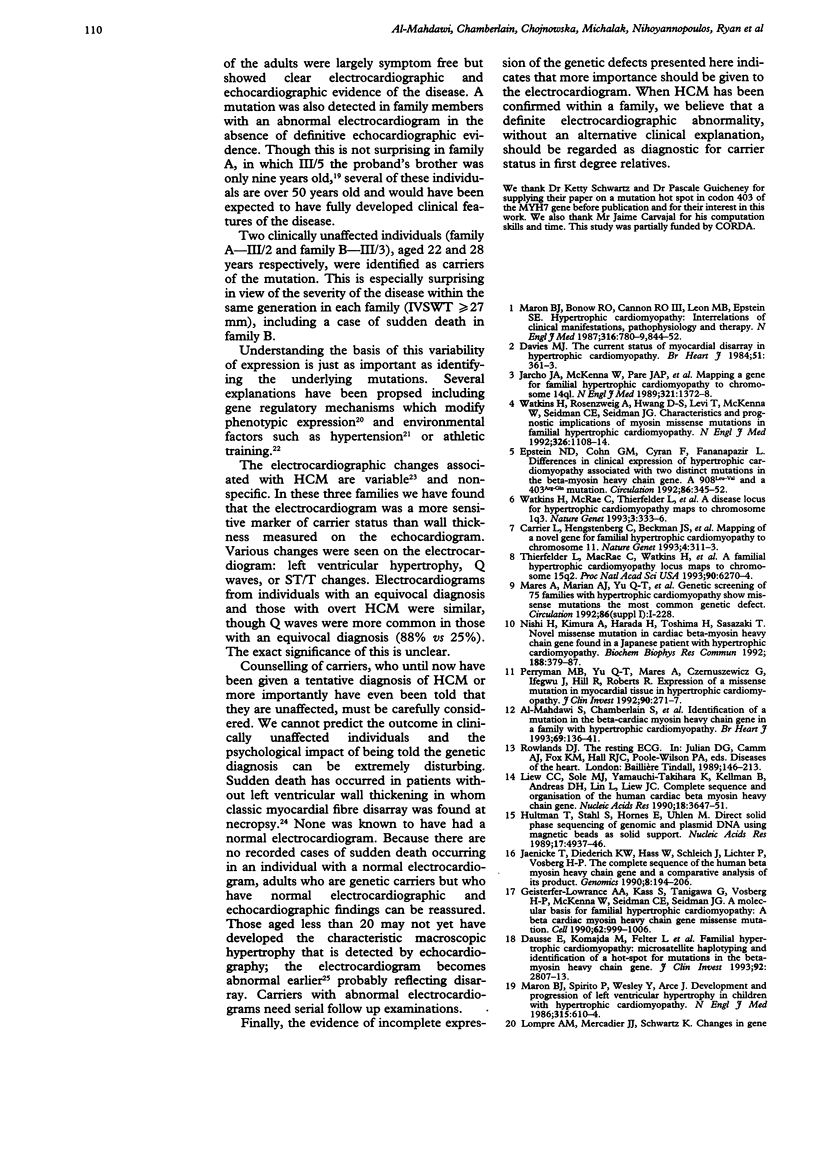
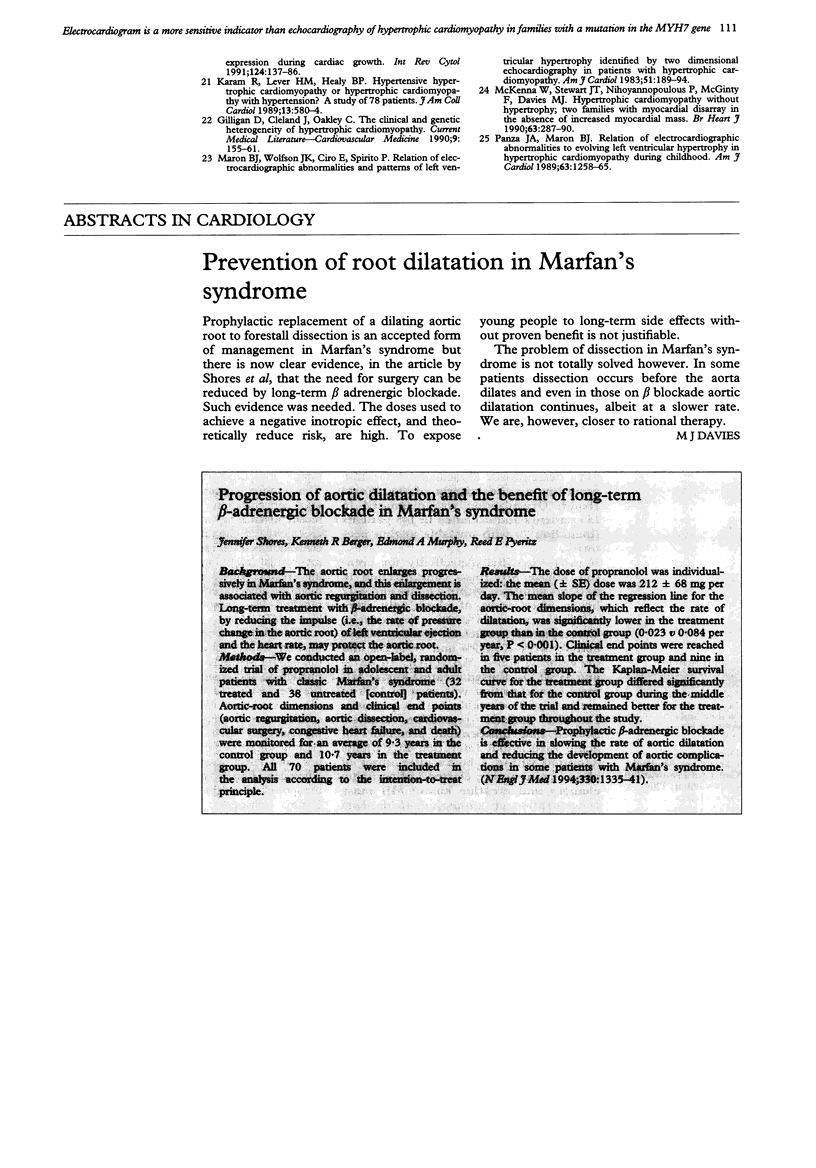
Images in this article
Selected References
These references are in PubMed. This may not be the complete list of references from this article.
- Carrier L., Hengstenberg C., Beckmann J. S., Guicheney P., Dufour C., Bercovici J., Dausse E., Berebbi-Bertrand I., Wisnewsky C., Pulvenis D. Mapping of a novel gene for familial hypertrophic cardiomyopathy to chromosome 11. Nat Genet. 1993 Jul;4(3):311–313. doi: 10.1038/ng0793-311. [DOI] [PubMed] [Google Scholar]
- Dausse E., Komajda M., Fetler L., Dubourg O., Dufour C., Carrier L., Wisnewsky C., Bercovici J., Hengstenberg C., al-Mahdawi S. Familial hypertrophic cardiomyopathy. Microsatellite haplotyping and identification of a hot spot for mutations in the beta-myosin heavy chain gene. J Clin Invest. 1993 Dec;92(6):2807–2813. doi: 10.1172/JCI116900. [DOI] [PMC free article] [PubMed] [Google Scholar]
- Davies M. J. The current status of myocardial disarray in hypertrophic cardiomyopathy. Br Heart J. 1984 Apr;51(4):361–363. doi: 10.1136/hrt.51.4.361. [DOI] [PMC free article] [PubMed] [Google Scholar]
- Epstein N. D., Cohn G. M., Cyran F., Fananapazir L. Differences in clinical expression of hypertrophic cardiomyopathy associated with two distinct mutations in the beta-myosin heavy chain gene. A 908Leu----Val mutation and a 403Arg----Gln mutation. Circulation. 1992 Aug;86(2):345–352. doi: 10.1161/01.cir.86.2.345. [DOI] [PubMed] [Google Scholar]
- Geisterfer-Lowrance A. A., Kass S., Tanigawa G., Vosberg H. P., McKenna W., Seidman C. E., Seidman J. G. A molecular basis for familial hypertrophic cardiomyopathy: a beta cardiac myosin heavy chain gene missense mutation. Cell. 1990 Sep 7;62(5):999–1006. doi: 10.1016/0092-8674(90)90274-i. [DOI] [PubMed] [Google Scholar]
- Hultman T., Ståhl S., Hornes E., Uhlén M. Direct solid phase sequencing of genomic and plasmid DNA using magnetic beads as solid support. Nucleic Acids Res. 1989 Jul 11;17(13):4937–4946. doi: 10.1093/nar/17.13.4937. [DOI] [PMC free article] [PubMed] [Google Scholar]
- Jaenicke T., Diederich K. W., Haas W., Schleich J., Lichter P., Pfordt M., Bach A., Vosberg H. P. The complete sequence of the human beta-myosin heavy chain gene and a comparative analysis of its product. Genomics. 1990 Oct;8(2):194–206. doi: 10.1016/0888-7543(90)90272-v. [DOI] [PubMed] [Google Scholar]
- Jarcho J. A., McKenna W., Pare J. A., Solomon S. D., Holcombe R. F., Dickie S., Levi T., Donis-Keller H., Seidman J. G., Seidman C. E. Mapping a gene for familial hypertrophic cardiomyopathy to chromosome 14q1. N Engl J Med. 1989 Nov 16;321(20):1372–1378. doi: 10.1056/NEJM198911163212005. [DOI] [PubMed] [Google Scholar]
- Karam R., Lever H. M., Healy B. P. Hypertensive hypertrophic cardiomyopathy or hypertrophic cardiomyopathy with hypertension? A study of 78 patients. J Am Coll Cardiol. 1989 Mar 1;13(3):580–584. doi: 10.1016/0735-1097(89)90596-2. [DOI] [PubMed] [Google Scholar]
- Liew C. C., Sole M. J., Yamauchi-Takihara K., Kellam B., Anderson D. H., Lin L. P., Liew J. C. Complete sequence and organization of the human cardiac beta-myosin heavy chain gene. Nucleic Acids Res. 1990 Jun 25;18(12):3647–3651. doi: 10.1093/nar/18.12.3647. [DOI] [PMC free article] [PubMed] [Google Scholar]
- Maron B. J., Bonow R. O., Cannon R. O., 3rd, Leon M. B., Epstein S. E. Hypertrophic cardiomyopathy. Interrelations of clinical manifestations, pathophysiology, and therapy (1). N Engl J Med. 1987 Mar 26;316(13):780–789. doi: 10.1056/NEJM198703263161305. [DOI] [PubMed] [Google Scholar]
- Maron B. J., Spirito P., Wesley Y., Arce J. Development and progression of left ventricular hypertrophy in children with hypertrophic cardiomyopathy. N Engl J Med. 1986 Sep 4;315(10):610–614. doi: 10.1056/NEJM198609043151003. [DOI] [PubMed] [Google Scholar]
- Maron B. J., Wolfson J. K., Ciró E., Spirito P. Relation of electrocardiographic abnormalities and patterns of left ventricular hypertrophy identified by 2-dimensional echocardiography in patients with hypertrophic cardiomyopathy. Am J Cardiol. 1983 Jan 1;51(1):189–194. doi: 10.1016/s0002-9149(83)80034-4. [DOI] [PubMed] [Google Scholar]
- McKenna W. J., Stewart J. T., Nihoyannopoulos P., McGinty F., Davies M. J. Hypertrophic cardiomyopathy without hypertrophy: two families with myocardial disarray in the absence of increased myocardial mass. Br Heart J. 1990 May;63(5):287–290. doi: 10.1136/hrt.63.5.287. [DOI] [PMC free article] [PubMed] [Google Scholar]
- Nishi H., Kimura A., Harada H., Toshima H., Sasazuki T. Novel missense mutation in cardiac beta myosin heavy chain gene found in a Japanese patient with hypertrophic cardiomyopathy. Biochem Biophys Res Commun. 1992 Oct 15;188(1):379–387. doi: 10.1016/0006-291x(92)92396-f. [DOI] [PubMed] [Google Scholar]
- Panza J. A., Maron B. J. Relation of electrocardiographic abnormalities to evolving left ventricular hypertrophy in hypertrophic cardiomyopathy during childhood. Am J Cardiol. 1989 May 15;63(17):1258–1265. doi: 10.1016/0002-9149(89)90187-2. [DOI] [PubMed] [Google Scholar]
- Perryman M. B., Yu Q. T., Marian A. J., Mares A., Jr, Czernuszewicz G., Ifegwu J., Hill R., Roberts R. Expression of a missense mutation in the messenger RNA for beta-myosin heavy chain in myocardial tissue in hypertrophic cardiomyopathy. J Clin Invest. 1992 Jul;90(1):271–277. doi: 10.1172/JCI115848. [DOI] [PMC free article] [PubMed] [Google Scholar]
- Schuler G., Hambrecht R., Schlierf G., Niebauer J., Hauer K., Neumann J., Hoberg E., Drinkmann A., Bacher F., Grunze M. Regular physical exercise and low-fat diet. Effects on progression of coronary artery disease. Circulation. 1992 Jul;86(1):1–11. doi: 10.1161/01.cir.86.1.1. [DOI] [PubMed] [Google Scholar]
- Thierfelder L., MacRae C., Watkins H., Tomfohrde J., Williams M., McKenna W., Bohm K., Noeske G., Schlepper M., Bowcock A. A familial hypertrophic cardiomyopathy locus maps to chromosome 15q2. Proc Natl Acad Sci U S A. 1993 Jul 1;90(13):6270–6274. doi: 10.1073/pnas.90.13.6270. [DOI] [PMC free article] [PubMed] [Google Scholar]
- Watkins H., MacRae C., Thierfelder L., Chou Y. H., Frenneaux M., McKenna W., Seidman J. G., Seidman C. E. A disease locus for familial hypertrophic cardiomyopathy maps to chromosome 1q3. Nat Genet. 1993 Apr;3(4):333–337. doi: 10.1038/ng0493-333. [DOI] [PubMed] [Google Scholar]
- Watkins H., Rosenzweig A., Hwang D. S., Levi T., McKenna W., Seidman C. E., Seidman J. G. Characteristics and prognostic implications of myosin missense mutations in familial hypertrophic cardiomyopathy. N Engl J Med. 1992 Apr 23;326(17):1108–1114. doi: 10.1056/NEJM199204233261703. [DOI] [PubMed] [Google Scholar]
- al-Mahdawi S., Chamberlain S., Cleland J., Nihoyannopoulos P., Gilligan D., French J., Choudhury L., Williamson R., Oakley C. Identification of a mutation in the beta cardiac myosin heavy chain gene in a family with hypertrophic cardiomyopathy. Br Heart J. 1993 Feb;69(2):136–141. doi: 10.1136/hrt.69.2.136. [DOI] [PMC free article] [PubMed] [Google Scholar]



